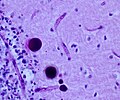Glycogen storage diseases
Jump to navigation
Jump to search
The printable version is no longer supported and may have rendering errors. Please update your browser bookmarks and please use the default browser print function instead.
Glycogen storage diseases a group of diseases characterized by the accumulation of glycogen.
Clinical picture
- Exercise intolerance
- Usually due to specific muscle enzyme defects
DDx:
- Mitochondriopathies
- Carnitine palmitoyltransferase II (CPT2) deficiency
General microscopic
Features:[1]
- +/-Vacuolated muscle fibres.
- acid phosphatase+ve in vaculoes.
- PAS+ve.
Images:
Electron microscopy
- Electron dense deposits.
Specific diseases
Pompe disease
- AKA glycogen storage disease type II, AKA acid maltase deficiency, AKA alpha-1,4-glucosidase deficiency.[2]
General
- Deficiency of alpha-1,4-glucosidase; it degrades glycogen to glucose in lysosomes.
- Autosomal recessive inheritance.
- Identified in 1932 by dutch pathologist Johannes C. Pompe.[3]
- A enzyme replacement therapy exists. [4]
Clinical
- infantile onset (usually at age 4-8months):
- Floppy baby.
- Macroglossia.
- Hepatomegaly.
- Big heart - often early death from cardiac failure.
- late onset (usually at age 1-2years):
- Progressive muscle weakness (myopathy).
- Usually only mild cardiac involvement.
Note: clinical course correlates with remaining enzyme activity.[5]
Diagnosis
- Mutations in acid alpha-glucosidase.
- Elevated serum CK (<10x).
- Cytoplasmic (lysosomal) vacuoles (Acid phosphatase +ve).
- Muscle fibers with vacuoles enlarged.
- Type 1 fibers more often affected.
- PAS+ve deposits.
- Autophagic (Lysosomal) vacuoles in electron microscopy.
Cori disease
General
- Hepatomegaly.
Microscopic
Features:
- Hypertrophic hepatocytes with pale cytoplasm.
- Classically: PAS +ve, PAS-D -ve.
- Portal fibrosis.
Image:
Stains
See also
References
- ↑ URL: http://neuromuscular.wustl.edu/pathol/acidmchi.htm. Accessed on: 11 January 2011.
- ↑ URL: http://www.ncbi.nlm.nih.gov/omim/606800. Accessed on: 11 January 2011.
- ↑ Pompe J-C. Over idiopatische hypertropie van het hart. Ned Tijdscr Geneeskd 1932; 76:304.
- ↑ Amalfitano, A.; Bengur, AR.; Morse, RP.; Majure, JM.; Case, LE.; Veerling, DL.; Mackey, J.; Kishnani, P. et al. "Recombinant human acid alpha-glucosidase enzyme therapy for infantile glycogen storage disease type II: results of a phase I/II clinical trial.". Genet Med 3 (2): 132-8. doi:10.109700125817-200103000-00007. PMID 11286229.
- ↑ Hermans, MM.; van Leenen, D.; Kroos, MA.; Beesley, CE.; Van Der Ploeg, AT.; Sakuraba, H.; Wevers, R.; Kleijer, W. et al. (Jan 2004). "Twenty-two novel mutations in the lysosomal alpha-glucosidase gene (GAA) underscore the genotype-phenotype correlation in glycogen storage disease type II.". Hum Mutat 23 (1): 47-56. doi:10.1002/humu.10286. PMID 14695532.
- ↑ URL: http://www.ncbi.nlm.nih.gov/omim/232400. Accessed on: 25 January 2011.






